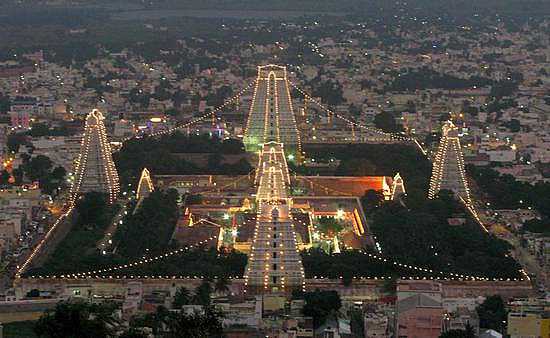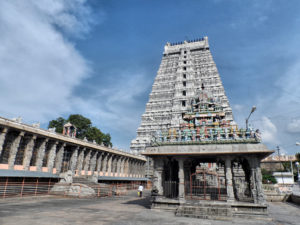
The Arunachalesvara temple is a Hindu temple situated in Thiruvannamalai and sits at the base of the Arunachala hill dedicated to the deity Lord Shiva who is represented by a Lingam that represents virtue, duty, self-sacrifice and liberation through ascetic life at the end of Agni kalpa. It is one of the temples associated with the Pancha Bhoota Stalas referring thr five elements or five Shiva temples manifesting land, water, air, sky, and fire. This temple falls under the significance of Hindu sect of Saivism.

It is said to be that at the top of Mount Kailash in a flower garden, Parvati, wife of Shiva playfully closed her husband’s eyes which resulted in submerging the Universe and the Earth without light and was pushed in darkness for years. To regain the light of the world, Parvati performed penance along with the devotees of Shiva which resulted in the returning of the light where her husband stood as a column of fire on the Arunachala hills lying behind the Arunachalesvara temple, where together Parvati and Shiva became the Ardhanarishvara (half-male, half-female form of Shiva).
The hill is considered as a lingam and is sacred, and is a representation of Shiva, in itself. Another famous scene of the temple is the lingothbava (seen on western sanctum walls of Shiva temple) where Vishnu and Brahma fought for superiority and Shiva challenged them appearing as a flame. Brahma became a swan, flew to the top of the flame and Vishnu to its base became the boar Varaha. Vishnu conceded his defeat but Brahma lied saying he found the pinnacle. In turn of lying, Shiva punished Brahma ordaining him to have no temples on earth in his worship.

 The history of the temple falls under various rulers along a vast period of time. History takes us back to the 9th century. The towers built by the Chola kings and inscriptions dates before 9th century where it was ruled by the Pallava kings from Kanchipuram. For more than four centuries from 850 to 1280, the Chola kings ruled over the region who were temple patrons recording various victories of the dynasty in the inscriptions. After the downfall of the Mughals post 1753, the temple was handled by both Hindu and Muslim stewardship with Krishna Raya, Muraru Raya, Burkat Ullakhan and Mrithis Ali Khan. In 1757, the French occupied the town and the temple, post which it came under the British rule in 1760 and later Tippu Sultan captured Thiruvannamalai in 1790. British ruled the town and the temple in the early 19th century. From 1951, the temple has been maintained by the Hindu Religious and Endowment Board of the Government (HR &CE) of Tamil Nadu under the provision of the Hindu Religious and Charitable Endowments Act. The temple is a national heritage monument and took over its stewardship in 2002 by the Archaeological Survey of India. The Archaeological Survey was led to go by the Supreme Court of India capitulate the shrine back to the Hindu Religious and Endowment Board because of the various cases and protests. Tamil was the main language used in the inscriptions with some in Sanskrit and Kannada. Devotees take up walking around the hill as an offer to god which is called Girivalam. The Girivalam path measures about 14km and is the road encircling the mountain where the holy mountain measures about 800m and the devotees circumbulate around it during the festival and full moon days. There are eight Lingams, eight Nandis many mandapas and more than 350 tanks around the hill.
The history of the temple falls under various rulers along a vast period of time. History takes us back to the 9th century. The towers built by the Chola kings and inscriptions dates before 9th century where it was ruled by the Pallava kings from Kanchipuram. For more than four centuries from 850 to 1280, the Chola kings ruled over the region who were temple patrons recording various victories of the dynasty in the inscriptions. After the downfall of the Mughals post 1753, the temple was handled by both Hindu and Muslim stewardship with Krishna Raya, Muraru Raya, Burkat Ullakhan and Mrithis Ali Khan. In 1757, the French occupied the town and the temple, post which it came under the British rule in 1760 and later Tippu Sultan captured Thiruvannamalai in 1790. British ruled the town and the temple in the early 19th century. From 1951, the temple has been maintained by the Hindu Religious and Endowment Board of the Government (HR &CE) of Tamil Nadu under the provision of the Hindu Religious and Charitable Endowments Act. The temple is a national heritage monument and took over its stewardship in 2002 by the Archaeological Survey of India. The Archaeological Survey was led to go by the Supreme Court of India capitulate the shrine back to the Hindu Religious and Endowment Board because of the various cases and protests. Tamil was the main language used in the inscriptions with some in Sanskrit and Kannada. Devotees take up walking around the hill as an offer to god which is called Girivalam. The Girivalam path measures about 14km and is the road encircling the mountain where the holy mountain measures about 800m and the devotees circumbulate around it during the festival and full moon days. There are eight Lingams, eight Nandis many mandapas and more than 350 tanks around the hill.